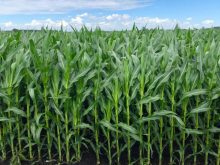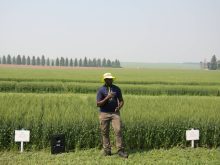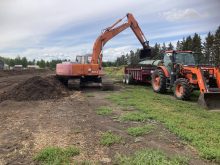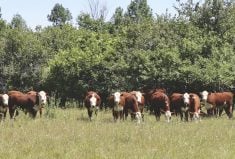[UPDATED: Jan. 17, 2023] Canadian crop producers can reduce emissions from nitrogen fertilizer by double digits and still turn a healthy profit, says a report prepared for the country’s leading fertilizer advocate. However, even that will still fall short of the federal government’s nitrous oxide emissions goals.
“To put it in broad strokes, the crop sector can achieve some pretty decent reductions and some pretty nice increases in its economics if we don’t get too crazy about this,” said Dan Heaney, an Alberta soil scientist and co-author of a report prepared for Fertilizer Canada.
*The report, released with little fanfare in September, says farmers can reduce nitrous oxide emissions from nitrogen fertilizer by 14 per cent (or 1.6 megatonnes of carbon dioxide equivalent) from 2020 levels through an “aggressive but attainable level of 4R BMPs (best management practices).”
Read Also

Beware giving horses too much iron
Horses consuming too much iron through diet or well water risk health problems like laminitis. Mineral testing forage and water is good practice for owners.
This strategy would boost farm incomes across Canada by $4.3 billion, offsetting a $495 million annual expense of implementing the BMPs, it says.
But the 14 per cent reduction is less than half of the federal government’s goal of reducing emissions by 30 per cent by 2030.
[RELATED] Opinion: The emissions controversy offers an opportunity for both sides
That would require aggressive adoption of 4R practices on the majority of acres over the next eight years, said Heaney, an Edmonton consultant and former vice-president of global agronomy for Farmers Edge.
“If you looked out to 2050, it might be possible,” he said. “We just don’t think that’s technically feasible by 2030 given we’re already in 2022.”
Even a more moderate target would take considerable effort and require farmers to invest significant dollars in 4R – using the right fertilizer source at the right rate at the right time and in the right place.
“It’s going to take incentives,” said Heaney. “Farmers are going to need to know more about (4R BMPs) and the agronomists will need to better understand what works and what doesn’t work in different areas.”
The purpose of the report, co-authored by Ontario economist Rob Gamble, was to “attach some economics” that were lacking in the federal government’s proposal, said Heaney.
[RELATED] Farmtario: Farmers at the forefront of reducing GHG emissions
“The idea behind (the report) was to get the emissions and the economics tied together and see just how feasible a 30 per cent reduction was, both technically and economically.”
Rapid change not realistic
Heaney and Gamble looked at scenarios measuring various levels of adoption of 4R practices and yield goals in order to achieve emissions numbers and financial returns to farmers.
“There’s very limited data in Canada on farm-level practices around fertilizer management,” said Heaney. “The best source we had for most of these BMPs was Fertilizer Canada’s fertilizer use survey.
“It’s been going on a number of years. It hasn’t covered every crop in every region but we had enough there that we could make kind of a best estimate or first approximation of the adoption rates of some of these BMPs and so we used that data to set our baseline.”
To achieve a 30 per cent reduction would require virtually every crop producer in Ontario and Quebec to adopt 4R BMPs, and the western half of the country would need adoption rates of 60 to 70 per cent. Current adoption rates are higher in Ontario and Quebec so the magnitude of change would be similar in both regions.
But that sort of rapid adoption is not realistic, the two researchers concluded.
“The adoption rates we were using were an order of magnitude increase in the adoption of some of the BMPs and the adoption of multiple BMPs on each and every acre,” said Heaney.
[RELATED] Cutting fertilizer emissions and cutting fertilizer use aren’t the same thing
The report refers to “advanced BMPs.” Although these differ by region, in Alberta they might include nitrification inhibitors, controlled-release fertilizers, or a double-inhibited product like a nitrification urease inhibitor, said Heaney.
“The science that’s been done on those emissions shows that (nitrification urease inhibitors) may be reducing nitrous oxide emissions by up to 50 per cent,” said Heaney.
But the biggest “bang for your buck” includes variable rate equipment and section control technology, he added.
“Some of these spatial management techniques I think are where farmers are going to make their money back,” he said.
But, there’s a but.
“There are capital costs they have to build in,” said Heaney. “Section control, from what we could see, would be a paying proposition for a lot of growers but it’s attached to changing your drill out.
“So you’re not going to go out this spring and change your drill out if it’s got five more years of useful life just so you can meet a nitrous oxide reduction target.”
Reasonable objectives needed
Another problem with adopting these and other 4R best management practices is that none of them are included in the National Inventory Report. This is the government’s official greenhouse gas inventory, which is used to report progress on greenhouse gas emissions as part of international obligations.
“At the moment it doesn’t account for these BMPs. If 20 per cent of growers are using enhanced efficiency fertilizer and that reduces nitrous oxide levels by some percentage, the NIR is entirely blind to that at the moment. It is only based on fertilizer rate.”
Carbon sequestration efforts meet a similar fate, said Heaney.
“Alberta growers have been particularly effective in adopting things like reduced and zero tillage and have sequestered millions of tonnes of carbon dioxide out of the atmosphere and back into the soil,” he said. “That carbon sequestration piece isn’t even accounted for in the same section of the NIR as fertilizer emissions.
“So farmers are getting targeted with having to reduce their fertilizer emissions but getting no credit for carbon sequestration.”
Fertilizer Canada is working with the feds to incorporate some of these grassroots efforts into the greenhouse gas inventory, said Heaney.
“But we don’t know what level it’s going to come in at. We don’t know if the use of enhanced efficiency fertilizer – if they get it in – is going to be credited at a 10, 25 or 35 per cent reduction,” he said.
“They’ve got this 30 per cent reduction target but none of the tools were put in place to actually measure it. As the old saying goes, you can’t measure it if you can’t manage it. So we’re kind of going into the future blind.”
The federal Liberal government announced its “30 per cent by 2030” intentions in 2020. Since then, there’s been a lot of misunderstanding around the scheme, including a notion that the 30 per cent cut was attached to N fertilizer use itself rather than emissions.
A lot of this confusion could have been avoided if producers had been consulted beforehand, said Cassandra Cotton, vice-president of policies and programs with Fertilizer Canada.
“There was no consultation with anybody in the ag sector so everyone was kind of taken aback,” she said. “There was no analysis or economic modelling. We had very little information in terms of what that target meant, how they were going to achieve it and how it was going to be mandated.”
Ottawa and the crops sector remain divided on a key issue. The government’s target is to reduce overall emissions by 30 per cent, while farm and industry groups want an intensity-based approach – the amount of emissions per bushel.
“By the very definition of looking at absolute emissions, we don’t believe that 30 per cent is achievable realistically without hurting farmers,” said Cotton. “It’s voluntary at this point but what happens in 2030 if we’re not able to make the progress?”
Although Heaney and Gamble’s report has been positively received by government officials, the crop sector can’t afford to be complacent, she said.
“I think we’ve made some progress with the tone of this policy compared to when it came out on 2020,” said Cotton. “We’ve had some assurances that it’s voluntary and we’ve had some assurances that they want to provide growers with incentives. They’ve been very supportive of the 4R framework. Those are all good for industry.
“But I don’t think we can take our foot off the gas. We need to ensure that’s being maintained going forward.”
Said Heaney, “I would view this as more of an ongoing discussion with the federal government about what’s feasible, what’s possible, the trade-offs and where can the crop sector and the government come to some reasonable understanding of what’s possible so we set everybody up for success rather than going a bridge too far.”
The report can be found in the Resources section of www.fertilizercanada.ca or at www.tinyurl.com/yc7rtczw
*Update: The article originally stated 1.6 tonnes instead of megatonnes.
















